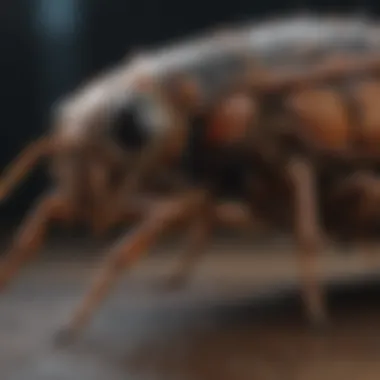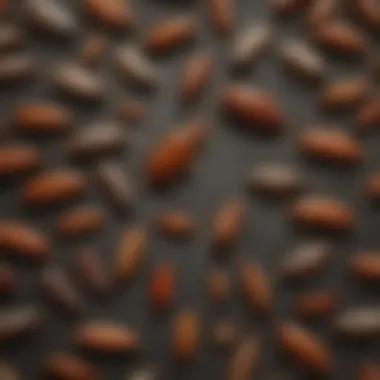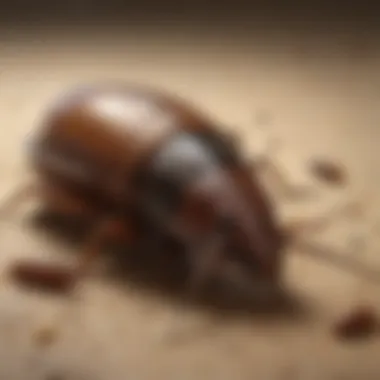Identifying the Best Roach: A Comprehensive Guide


Intro
Understanding the different species of roaches is essential not just for eliminating pests but also for appreciating their ecological significance. Roaches occupy a unique position in the ecosystem. They contribute to organic matter breakdown and act as a food source for other wildlife. However, some species can become nuisances in homes, leading to health concerns and property damage. This guide will serve as a comprehensive resource for identifying different roach species, understanding their behavior, and implementing effective strategies for control when necessary.
Pest Identification
Common Household Pests
Roaches belong to the order Blattodea and are divided into several species, each with unique characteristics. Some common household pests include:
- German Cockroach: This small, light brown insect often infests kitchens and bathrooms. Its rapid reproduction rate makes it particularly troublesome.
- American Cockroach: Larger than the German variety, the American cockroach is reddish-brown and often found in basements and sewers. It prefers warm, humid environments.
- Oriental Cockroach: Dark brown or black, these roaches thrive in damp places like drains and garbage areas. While less likely to infest homes, they can still appear indoors.
Identifying these species is crucial. Different species have varying behaviors and controls.
Signs of Infestation
Recognizing signs of a roach infestation early can help mitigate problems. Look for:
- Droppings: Small, dark, cylindrical droppings found near food sources or nesting areas.
- Egg Cases: Casings that are brown and oval-shaped, often found in hidden places like in cabinets or behind furniture.
- Smeared Marks: Dark streaks where roaches travel frequently.
Understanding these signs allows homeowners to detect issues before they worsen.
Prevention Methods
Environmental Modifications
Keeping an environment inhospitable to roaches is a strong first line of defense. Some effective modifications include:
- Sealing Cracks: Inspect the home for any cracks and openings that may serve as entry points.
- Proper Waste Management: Ensure trash is disposed of properly, using sealed bins to reduce attractants.
- Moisture Control: Fix leaks and reduce excess moisture since roaches thrive in humid conditions.
Home Maintenance Tips
Regular upkeep plays a vital role in prevention. Key activities include:
- Clean Regularly: Maintain cleanliness by sweeping and mopping floors, especially in the kitchen.
- Store Food Properly: Keep food in airtight containers to avoid attracting pests.
- Frequent Inspections: Look for signs of infestation regularly to stay ahead of any potential issues.
DIY Pest Control Solutions
When prevention is not enough, consider some do-it-yourself pest control measures.
Natural Remedies
Using natural ingredients can be an effective way to combat roaches without the use of harsh chemicals. Some remedies include:
- Boric Acid: This natural compound can be sprinkled in areas where roaches are seen.
- Diatomaceous Earth: A non-toxic powder that damages a roach’s exoskeleton, leading to dehydration and demise.
DIY Traps and Barriers
Setting traps can significantly reduce roach populations. To make a simple trap:
- Use a jar with a bit of an adhesive substance on the inside to catch the roaches as they climb in.
Additionally, using barriers such as baking soda mixed with sugar can lure and kill roaches.
Effective pest management combines both understanding and action. Knowing which roaches are present and how they behave allows for targeted control measures.
Prologue to Roaches
Roaches often evoke a sense of distaste among many, but their importance in various environments cannot be overlooked. In this section, we explore why understanding roaches is crucial for both domestic settings and broader ecological contexts. Roaches are diverse creatures, playing various roles in ecosystems that can range from beneficial to detrimental. This broad spectrum of characteristics among species signifies that not all roaches are equal.


By studying roaches, homeowners can gain insights into effective pest management strategies. Knowledge about different species assists in distinguishing between those that may be a nuisance and those that are inherently beneficial. Proper identification aids in targeted action, reducing unnecessary harm to the environment.
Moreover, recognizing the ecological contributions of roaches enhances our comprehension of their place within food webs and nutrient cycling. For many, this perspective shifts the narrative from viewing roaches solely as pests to understanding their integral role in maintaining ecosystem balance. The importance of this topic resonates broadly, influencing attitudes towards pest management and environmental stewardship.
Understanding the Diversity of Roach Species
Roaches comprise a vast array of species, each with distinct characteristics and behaviors. There are over 4,500 known species of roaches, but only a small fraction are typically associated with human habitats. Among these, the American cockroach, German cockroach, and Oriental cockroach are the most well-known. Each species exhibits unique adaptations that allow for survival in a variety of environments.
- American Cockroach: Often found in warm and humid areas, this species is known for its large size and quick movements. They thrive in sewers and basements, which contribute to their reputation as pests.
- German Cockroach: Commonly found in kitchens and bathrooms, the German cockroach is notorious for its rapid reproduction. Its small size and ability to fit into narrow crevices make it particularly challenging to eradicate.
- Oriental Cockroach: This species prefers cooler, damp environments and is common in basements. Unlike the other species, the Oriental cockroach is not as fast-moving, which affects its behavior around humans.
Understanding these differences is vital for effective pest management and ecological consideration. Knowledge about species traits, habitat preferences, and behaviors can inform appropriate strategies tailored to specific roach types, ultimately promoting better understanding.
The Role of Roaches in Ecosystems
Despite the negative perceptions surrounding them, roaches play an essential role in their ecosystems. They contribute to decomposition processes by feeding on decaying organic matter, thereby facilitating nutrient recycling. This role is crucial for soil health and plant growth as it breaks down complex organic materials into simpler compounds that plants can use.
Additionally, roaches serve as food for several predators within the food web. Birds, reptiles, and certain mammals rely on roaches as a part of their diet. In this way, roaches help sustain the population dynamics of various species in their habitats.
"Roaches are often underestimated in their value to ecosystems; they form a critical part of a balanced environment and contribute significantly to nutrient cycling."
Their presence indicates a balanced ecosystem, and understanding their role can help mitigate the impulse to eliminate them without considering the consequences. Through proper understanding of roaches, there is an opportunity for homeowners and professionals to appreciate their ecological significance, leading to more informed decisions concerning pest control practices.
Characteristics of Roaches
Understanding the characteristics of roaches is crucial for several reasons. First, it helps differentiate between various species and their roles within different ecosystems. This knowledge aids homeowners in determining how to manage or control their presence in human environments. Additionally, recognizing these characteristics allows for better-informed decisions, particularly in pest control and sustainable practices. This section delves into the physical features, behavioral traits, and reproductive patterns that define these insects.
Physical Features
The physical features of roaches vary widely across different species. Most cockroaches share common traits, such as elongated bodies and a relatively flat shape, which help them escape predators and navigate through narrow spaces. Typically, an adult roach measures between 1 and 4 inches in length. The coloration can range from light brown to almost black.
Another important aspect is the presence of long antennae, which can be several times the length of their body. These antennae are sensory organs that help them detect changes in their environment. The wings of some species, like the American cockroach, allow for flight but it is minimal.
Behavioral Traits
Roaches are primarily nocturnal insects, meaning they are active during the night. This behavior aids them in avoiding predators and human interaction. They often prefer warm, moist environments, like kitchens or bathrooms, which provide food sources and suitable living conditions.
Roaches exhibit communal behavior. They often congregate in groups, particularly in habitats that provide adequate resources. This social structure can lead to faster reproduction rates and spreading of infestations. They are also known for their scavenging behavior, feeding on a variety of organic materials, including decaying matter, paper, and food leftovers. Recognizing these behavioral traits can help homeowners understand how to limit their habitats and food sources effectively.
Reproductive Patterns
Roaches possess reproductive strategies that allow them to thrive in diverse environments. Female cockroaches can produce an impressive number of eggs, sometimes laying up to 50 at once. The eggs are typically contained within a protective capsule known as an ootheca, which the female carries until they are ready to hatch.
Most roaches move through various life stages, from egg to nymph to adult. Nymphs resemble miniature adults but lack fully developed wings. This process of development can take several weeks to months, depending largely on species and environmental conditions such as temperature and availability of food.
"Knowledge about characteristics of roaches can prevent infestations and improve living conditions for homeowners."
By understanding these aspects, one can take proactive measures to handle any potential issues within their homes effectively.
Common Roach Species
Understanding common roach species is vital in identifying the best roach for various contexts, whether for pest control or ecological studies. Each species has unique characteristics, behaviors, and habitats, which influence how they interact with human environments. Recognizing these differences helps homeowners make informed decisions about how to approach roach management and can assist pest control experts in selecting appropriate strategies. Furthermore, some species may offer benefits in certain ecosystems while others may pose risks.
American Cockroach
The American Cockroach, also known as Periplaneta americana, is one of the most prevalent roach species found in both urban and rural settings. This species is quite large, typically measuring 1.5 to 2 inches in length, and is recognized for its reddish-brown coloration and long wings, though it is not a proficient flyer.
This cockroach is usually found in warm, moist environments such as bakeries, kitchens, and basements. Its presence may indicate sanitation issues, which makes it important for homeowners to be vigilant. Caring for this species involves meticulous cleaning and elimination of moisture sources.
German Cockroach
The German Cockroach, scientifically named Blattella germanica, is a smaller species, averaging about 1.1 to 2 inches in length. It is characterized by two parallel stripes on its pronotum, which is the part behind its head. This roach is notorious for being an indoor pest, often thriving in homes and restaurants.


German Cockroaches can reproduce rapidly, with a single female capable of producing thousands of offspring in her lifetime. This reproductive capability poses a significant challenge in pest control. Effective management practices include bait traps and professional extermination techniques. Staying aware of their presence can eliminate potential infestations and protect food sources.
Oriental Cockroach
The Oriental Cockroach, or Blatta orientalis, is distinguishable by its dark brown or black color and a robust body that can measure about 1 to 1.5 inches in length. Known as the "water bug," this species prefers damp environments often found in basements or drains.
Oriental Cockroaches are less likely to invade homes in the same manner as American and German species. However, they can still indicate underlying moisture issues. Containment measures should focus on improving sanitation and sealing possible entry points.
Brown-Banded Cockroach
The Brown-Banded Cockroach, or Supella longipalpa, stands out due to its lighter coloration and distinctive brown bands across its wings. Adult roaches typically measure around 0.5 to 1 inch in length. Unlike other roach species, Brown-Banded Cockroaches can thrive in less humid environments, making them often found in bedrooms and living areas.
Their ability to adapt to varying conditions poses a unique challenge for homeowners since they may go unnoticed until populations become significant. Regular inspections and creating less hospitable environments through cleaning can help manage their presence.
In summary, understanding these common roach species empowers homeowners to recognize potential infestations and take appropriate actions. Knowing the specific characteristics and habits of American, German, Oriental, and Brown-Banded cockroaches can lead to more effective management and, ultimately, a healthier living environment.
"Identifying the roach species in your home is the first step in tackling potential issues effectively."
While pest control is necessary for invasive species, some species play a role in the ecosystem. Understanding these common roach types aids in discerning when to employ aggressive management tactics and when to appreciate the natural roles they play.
Identifying the Best Roach for Various Contexts
Understanding the various contexts in which different roach species operate is crucial for several reasons. First, it helps in recognizing which species might be harmful and which may provide benefits to the environment. Homeowners and pest control professionals can use this knowledge to make informed decisions about management strategies. Identifying the best roach species is not merely an academic exercise; it has real-world implications for health, economics, and ecosystem balance. The ability to discriminate between beneficial and harmful species is foundational in pest management, as it facilitates targeted and efficient interventions.
Beneficial Roles of Roaches
Roaches often get a poor reputation due to their association with unsanitary conditions. However, they serve important roles in various ecosystems. Some species contribute to soil health through the decomposition of organic materials. For example, they help break down leaves and other plant matter, returning nutrients to the soil. This process is crucial for maintaining the balance in the ecosystem and promoting plant growth.
Additionally, certain roach species act as a food source for various predators, including birds and mammals. This predator-prey dynamic is an essential aspect of maintaining ecosystem diversity.
- Nutrient recycling: Roaches contribute to soil fertility by decomposing waste.
- Food source: They provide sustenance for numerous wildlife species.
- Detritivores: They play a key role in breaking down organic material.
While beneficial, their presence in urbanized areas must be managed in a way that does not promote pest-related issues.
Roaches as Pest Species
Despite their ecological benefits, some roach species are notorious for becoming pests. The German cockroach, for instance, is well-known for its rapid reproduction and ability to thrive in human habitats. Infestations can lead to significant health risks, as these roaches can spread pathogens and trigger allergies. Understanding the factors that contribute to their success in human environments is essential for control efforts.
Common pests include:
- German Cockroach: Prefers warm, humid areas and can reproduce quickly.
- American Cockroach: Known for its size and ability to survive in various conditions.
- Oriental Cockroach: Often found in basements and drains, it is highly resilient.
The economic impact of a roach infestation can be substantial, leading to damage in food supplies and increased health care costs. Homeowners should be vigilant in identifying signs of infestations early to implement control measures effectively.
Understanding the dual roles of roaches—beneficial and harmful—can lead to better management practices, enhancing both our environments and health.
Risks Associated with Roaches
Understanding the risks associated with roaches is crucial for maintaining a healthy living environment. These insects are not just a nuisance; they also pose serious health and economic threats. Awareness of these risks can guide homeowners and professionals in implementing effective management strategies. It is important to recognize how roaches interact with human environments and the consequences that arise from their presence.
Health Implications
Roaches are known carriers of various pathogens. They can spread bacteria, such as Salmonella and E. coli. These germs can lead to food poisoning and gastrointestinal illnesses. Their droppings, saliva, and shed skin can also trigger allergic reactions and asthma attacks, particularly in children and sensitive individuals. In fact, research shows that asthma prevalence is higher in urban areas where roach infestations are common.
Some key health risks include:
- Bacterial contamination: Roaches can contaminate food and surfaces where food is prepared.
- Allergen production: Their body parts and waste can produce allergens that lead to respiratory issues.
- Disease transmission: Roaches can transfer diseases through indirect contact with contaminated items.
"Effective pest control not only protects property but also preserves health."


Mitigating these health risks involves regular cleaning, sealing entry points, and utilizing pest control methods when necessary. Understanding these implications empowers homeowners to take preventive actions against infestations.
Economic Impact of Roach Infestations
The economic impact of roach infestations can be substantial, especially for businesses in the food service industry. A single infestation can lead to costly remediation measures, loss of reputation, and potential legal liabilities. Owners of restaurants or grocery stores must maintain strict sanitation standards to avoid infestation. The presence of roaches can lead to:
- Lost revenue: Customer perceptions can suffer, impacting sales.
- Increased operational costs: Fixed expenses increase due to the need for frequent cleaning and pest control.
- Regulatory fines: Health inspections may result in fines if infestations are present.
For residential areas, pest problems can also lead to higher maintenance costs. Homeowners might face increased utility bills due to compromised structures if infestations are not addressed promptly. Identifying and managing these risks ensures both health safety and economic viability for properties of all kinds.
Sustainable Management Practices
Sustainable management practices are essential when dealing with roach populations, whether they are beneficial species or pests. These practices prioritize ecosystem health and aim to minimize the impact on the environment while addressing the presence of roaches. By understanding suitable methods and strategies, homeowners can manage roach issues effectively while supporting overall ecological balance.
Benefits of Sustainable Management Practices
Implementing sustainable practices provides several advantages. Firstly, it reduces reliance on harmful chemical pesticides. This approach not only protects the environment but also safeguards the health of families and pets. Secondly, sustainable practices often lead to longer-lasting solutions, reducing the likelihood of reinfestation. Thirdly, these methods promote biodiversity and strengthen the resilience of local ecosystems by supporting beneficial organisms that can help control pest populations naturally.
Considerations for Effective Management
When adopting sustainable management practices, it is crucial to consider the specific context of each home. Factors such as location, existing roach species, and adjacent environments play vital roles in the effectiveness of chosen strategies. Additionally, understanding local regulations regarding pest management can guide homeowners in making informed decisions.
One of the key points is that education and awareness are fundamental. Homeowners should learn about different roach species and their behaviors. This knowledge will aid in selecting the most appropriate management techniques that fit individual needs while maintaining ecological integrity.
Preventive Measures
Preventive measures are the first line of defense against unwanted roach infestations. These approaches focus on creating environments that are inhospitable to roaches, thus reducing the chances of an outbreak.
Some effective strategies include:
- Sealing Entry Points: Identify cracks and gaps in walls, doors, and windows. Sealing these areas prevents roaches from entering the home.
- Proper Waste Management: Regularly dispose of garbage and store food in airtight containers. This practice minimizes accessible food sources for roaches.
- Maintaining Cleanliness: Vacuuming regularly and maintaining a tidy home reduce hideouts for roaches. Focus on areas under appliances and along baseboards.
By implementing these preventive steps, homeowners can significantly decrease the likelihood of roach infestations.
Eco-Friendly Eradication Techniques
When roach populations need to be controlled, eco-friendly eradication techniques can be a viable option. These methods emphasize the use of non-toxic substances that effectively address roach issues without harming the environment.
Some eco-friendly techniques include:
- Diatomaceous Earth: A natural product that is harmless to humans and pets but lethal to roaches. It works by damaging the exoskeletons of roaches when they come into contact with it.
- Boric Acid: When used in moderation, boric acid can be an effective and less toxic pesticide. It is important to apply it carefully and avoid areas accessible to pets and children.
- Essential Oils: Certain oils, such as peppermint and tea tree oil, can deter roaches with their strong scents. Mixing these oils with water and spraying areas prone to infestations can be helpful.
By integrating these eco-friendly techniques, homeowners can manage roach populations effectively while promoting sustainability in pest control practices.
The integration of sustainable management practices in pest control not only tackles immediate issues but also contributes to long-term ecological health.
The End
The conclusion section brings an essential summary and synthesis of the overall discussions about roaches. In this article, we have explored a range of topics from identifying various roach species to comprehending their impact in both beneficial and detrimental contexts. Understanding these aspects is crucial, particularly for homeowners who may encounter these pests.
The insights provided are not merely academic; they hold practical significance. Recognizing different roach species enables homeowners to adopt targeted measures, whether it be encouraging beneficial species or managing those that pose a risk. The duality of roaches as both essential components of the ecosystem and potential pests necessitates a balanced perspective in one’s approach to them.
Furthermore, the discussion of sustainable management techniques aligns with contemporary ecological values. Homeowners and professionals alike can benefit from applying eco-friendly practices that minimize harm to the environment while effectively controlling unwanted roach populations.
Ultimately, the conclusions drawn in this guide underscore the importance of informed decision-making and proactive measures regarding roaches.
Recap of Key Insights
Throughout our examination, several key insights emerged that are fundamental to addressing the subject of roaches:
- Diversity of Species: Understanding the different types of roaches is paramount. Each species has unique characteristics and behaviors which influence human interaction with them.
- Ecosystem Roles: Roaches play significant roles in decomposition and nutrient cycling. Their ecological importance cannot be overstated, even if they are often viewed solely as pests.
- Health and Economic Risks: The potential health implications and economic impacts associated with roach infestations highlight the need for vigilance and prompt action. Homeowners should be aware of these risks when addressing roach-related issues.
- Sustainable Practices: Knowledge of eco-friendly eradication techniques and preventive measures can help mitigate infestations responsibly and effectively.
Implications for Homeowners and Professionals
For homeowners, the insights gained from this article can lead to more effective strategies for managing roaches. By understanding the different species and their behaviors, they can tailor their approaches to suit specific situations. For instance, establishing a clean home environment can deter pests while promoting the growth of beneficial species that can contribute positively to household ecosystems.
Pest control professionals are encouraged to integrate the knowledge discussed here into their practices. Understanding the ecological roles of roaches allows them to apply targeted treatments that prioritize environmental health. This ensures they deal with infestations in a manner that considers the broader ecological impact.
"Informed pest management is vital for successfully balancing human needs and ecological considerations."
The implications extend beyond mere management techniques; they promote a greater awareness of interconnectedness within ecosystems. By adopting informed practices, homeowners and professionals can contribute to healthier living environments while respecting the complex roles that all species, including roaches, play in our world.















